|
|
Plants play a pivotal role in sustaining life on the Earth through oxygen production, carbon sequestration, water cycling, etc. The photosynthesis conducted by land plants and algae is the ultimate source of energy and organic material in nearly all ecosystems. Many animals rely on plants for shelter as well as oxygen and food. Land plants are key components of the water cycle and several other biogeochemical cycles. Some plants like legumes have coevolved with nitrogen fixing bacteria, making plants an important part of the nitrogen cycle. Plant roots play an essential role in soil development and prevention of soil erosion. Plant species adapt and grow with respect to the topography, geographical location, type of landscape and weather condition. The survival of plants in the campus is due to management with proper nourishment, water and protection. The campus is located in the typical deccan plateau landscape, with the diverse landscape of boulders, hillocks, vast crop fields, dry tracts with scrubs, human habitations, etc. Tall bottle palms at the entrance leads to the shining black statue of Sage Agasthyeshwara.
Agastya Foundation Campus, Kuppam
|
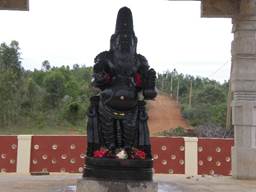
|
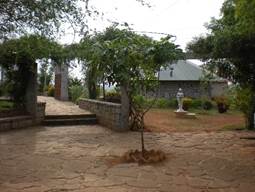
|
Sage Agasthya’s statue |
Quadrangle at entrance |
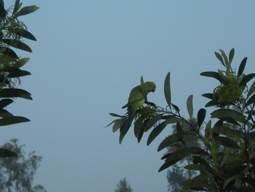
|
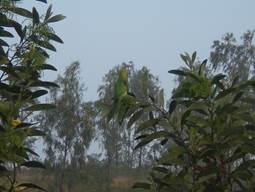
|
Rose ringed Parakeet feeding on Acacia pods at Acacia plantation |
Highlights of the campus flora and fauna: About 600 species of plants with the majority of them are native. The campus is being afforested and rejuvenated during the last decade. Examples of rejuvenated habitats are rare in the Eastern Ghats. The campus has become a habitat to diverse fauna. The conservation initiatives have yielded desired results evident from the transformation to a biodiversity rich landscape. There has been a total transformation of the campus in the past decade resulting in rocky wasteland being converted to a green campus with rich biodiversity. There are numerous shrubs of medicinal importance or aid as host plants for butterflies.
- During summer, Butea monosperma tree with red flowers (Flame of the forest, also called Muttuga in Kannada and Palasha in Sanskrit) and thousands of bees swarming around for nectar. The leaves of this tree are used for making plates (used for serving food during community meals). The tree bark is quite medicinal and the stems are considered holy for several rituals.
- During March-April months Cassia fistula (golden shower tree; in Kannada Kakke Mara) with yellow oleander flowering droops like a yellow light chandelier. It is said that flowering indicates the arrival of monsoon. The tree bark is used for folklore medicine. Fruits are elongated dark pods which are preferred by many animals. Amongst the scrub jungle, between thorny bushes one can appreciate a special type of tree,
- Dichrostachys cinerea (Chinese lantern tree)with unique type of flowers. There are two colours of flowers in single stalk - upper set of flowers is yellow and lower ones are pink colour and are sterile flowers. Entire tree is thorny and dry with small leaves. This tree is native to Africa but has been introduced to India.
Monoculture plantations of Acacia give the appearance of wooded forest, with less diversity. Rose ringed Parakeets have adapted to pecking the pods of these trees, inviting many such birds that forage for food. Acacia auriculiformis are exotic plants from Australia, being planted in large scale by the forest department to enhance the green cover and also to provide fuel wood. Leaf like part generally seen are not true leaves, but the leaf stalk modifying to leaf like part called ‘Phyllode’ for reducing the transpiration and water dependent activities as they survive arid conditions too. The young seedlings will have small leaflets which will fall away after sometime, once the leaf stalk modifies. The flowers attract hundreds of honey bees. The soil in the plantation region is with very less plant or animal life. The surrounding area is with several drier tract plants.
- About 137 species of birds were recorded of which 20% are migratory and arrive every winter. Several rare species of birds take shelter as the habitat is quite unique with undulating topography, rich with vegetation.
- 49 species of butterflies and at least 60 % breed regularly due to the presence of their hosts and nectar plants. Several of the butterfly species found on campus are quite rare and unique.
- 16 species of amphibians and 21 species of reptiles were recorded - reptiles like the Geckoella kollegalensis, Barred Wolf Snake, Golden Gecko, etc are reported for the first time in the Eastern Ghats,. This proves the richness of their habitat.
- 16 species of rare spiders (the Social Spider, found only in Africa and India, is abundant in the Campus).
- Several mammals like the Black-naped Hare, Pangolin, Porcupine, Indian Jackal, Spotted Deer, traces of leopard and sloth bear through scat and foot prints reveals that the campus is very rich and healthy with native vegetation and the habitat is preserved intact, which is helping to protect and conserve Biodiversity. Elephants are regular visitors in Kuppam every summer during the last five years and have entered Agastya Foundation Campus few times.
Diverse Flora and Fauna of the Campus |
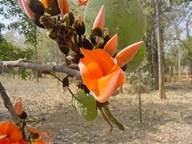
|
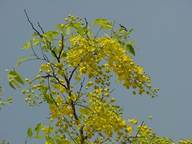
|
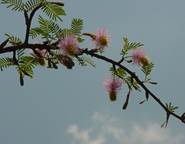
|
Butea monosperma (Flame of the forest) |
Cassia fistula (Yellow oleander) |
Dichrostachys cinerea |
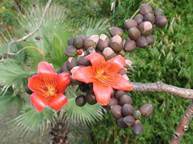
|
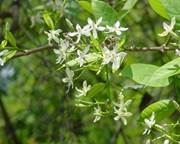
|
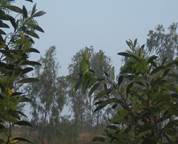
|
Bombax malabaricum (Red silk cotton) |
Wrightia tinctoria (dyers’s oleander) |
Acacia auriculiformis |

|

|

|
Pied Harrier |
Sirkeer malkoha |
Common jezebel |

|

|

|
Striped Tiger |
Cat Snake |
Barred Wolf Snake |

|

|

|
Social Spider |
Signature Spider |
Wolf Spider |
|




















